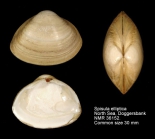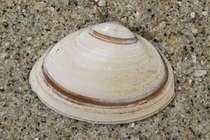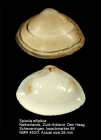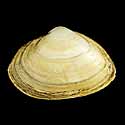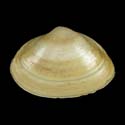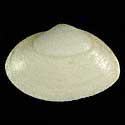MolluscaBase taxon details
Spisula elliptica (T. Brown, 1827)
140300 (urn:lsid:marinespecies.org:taxname:140300)
accepted
Species
Mactra elliptica T. Brown, 1827 · unaccepted
Mactra gracilis Locard, 1891 · unaccepted
Mactra luteola Lovén, 1846 · unaccepted
Spisula elliptica elliptica (T. Brown, 1827) · unaccepted
- Subspecies Spisula elliptica elliptica (T. Brown, 1827) accepted as Spisula elliptica (T. Brown, 1827)
marine
(of Mactra elliptica T. Brown, 1827) Brown, T. (1827). Illustrations of the conchology of Great Britain and Ireland. Drawn from nature. <em>W.H. Lizars and D. Lizars, Edinburgh and S. Highley, London.</em> 144 pp., 52 pls., available online at http://www.biodiversitylibrary.org/item/127868
page(s): Plate XV. Fig 6. [details]
page(s): Plate XV. Fig 6. [details]
Distribution S. elliptica has only been found at some locations south of 54'N in the Southern Bight and shows a marked concentration in...
Distribution S. elliptica has only been found at some locations south of 54'N in the Southern Bight and shows a marked concentration in big patches. The species is not present in the brackish waters. While the closely resembling species S. subtruncata is more common near the shore, S. elliptica also lives in more offshore parts. This distribution pattern has also been reported in an earlier investigation in 1964 (Eisma, 1966). [details]
MolluscaBase eds. (2024). MolluscaBase. Spisula elliptica (T. Brown, 1827). Accessed at: https://www.molluscabase.org/aphia.php?p=taxdetails&id=140300 on 2024-04-16
![]() The webpage text is licensed under a Creative Commons Attribution 4.0 License
The webpage text is licensed under a Creative Commons Attribution 4.0 License
original description
(of Mactra elliptica T. Brown, 1827) Brown, T. (1827). Illustrations of the conchology of Great Britain and Ireland. Drawn from nature. <em>W.H. Lizars and D. Lizars, Edinburgh and S. Highley, London.</em> 144 pp., 52 pls., available online at http://www.biodiversitylibrary.org/item/127868
page(s): Plate XV. Fig 6. [details]
original description (of Mactra gracilis Locard, 1891) Locard, A. (1891). Les coquilles marines des côtes de France. <em>Annales de la Société Linnéenne de Lyon.</em> 37: 1-385 [Published 31 October 1891; also published by Baillière as a book in 1892]., available online at https://www.biodiversitylibrary.org/page/54577547
page(s): 266 [details]
context source (Schelde) Maris, T.; Beauchard, O.; Van Damme, S.; Van den Bergh, E.; Wijnhoven, S.; Meire, P. (2013). Referentiematrices en Ecotoopoppervlaktes Annex bij de Evaluatiemethodiek Schelde-estuarium Studie naar “Ecotoopoppervlaktes en intactness index”. <em>Monitor Taskforce Publication Series, 2013-01. NIOZ: Yerseke.</em> 35 pp. (look up in IMIS) [details]
context source (BeRMS 2020) Bio-environmental research group; Institute of Agricultural and Fisheries research (ILVO), Belgium; (2015): Epibenthos and demersal fish monitoring data in function of wind energy development in the Belgian part of the North Sea. [details]
basis of record Gofas, S.; Le Renard, J.; Bouchet, P. (2001). Mollusca. in: Costello, M.J. et al. (eds), European Register of Marine Species: a check-list of the marine species in Europe and a bibliography of guides to their identification. <em>Patrimoines Naturels.</em> 50: 180-213., available online at http://www.vliz.be/imisdocs/publications/ocrd/254404.pdf [details]
additional source Huber, M. (2010). <i>Compendium of bivalves. A full-color guide to 3,300 of the world's marine bivalves. A status on Bivalvia after 250 years of research</i>. Hackenheim: ConchBooks. 901 pp., 1 CD-ROM. (look up in IMIS) [details]
page(s): Plate XV. Fig 6. [details]
original description (of Mactra gracilis Locard, 1891) Locard, A. (1891). Les coquilles marines des côtes de France. <em>Annales de la Société Linnéenne de Lyon.</em> 37: 1-385 [Published 31 October 1891; also published by Baillière as a book in 1892]., available online at https://www.biodiversitylibrary.org/page/54577547
page(s): 266 [details]
context source (Schelde) Maris, T.; Beauchard, O.; Van Damme, S.; Van den Bergh, E.; Wijnhoven, S.; Meire, P. (2013). Referentiematrices en Ecotoopoppervlaktes Annex bij de Evaluatiemethodiek Schelde-estuarium Studie naar “Ecotoopoppervlaktes en intactness index”. <em>Monitor Taskforce Publication Series, 2013-01. NIOZ: Yerseke.</em> 35 pp. (look up in IMIS) [details]
context source (BeRMS 2020) Bio-environmental research group; Institute of Agricultural and Fisheries research (ILVO), Belgium; (2015): Epibenthos and demersal fish monitoring data in function of wind energy development in the Belgian part of the North Sea. [details]
basis of record Gofas, S.; Le Renard, J.; Bouchet, P. (2001). Mollusca. in: Costello, M.J. et al. (eds), European Register of Marine Species: a check-list of the marine species in Europe and a bibliography of guides to their identification. <em>Patrimoines Naturels.</em> 50: 180-213., available online at http://www.vliz.be/imisdocs/publications/ocrd/254404.pdf [details]
additional source Huber, M. (2010). <i>Compendium of bivalves. A full-color guide to 3,300 of the world's marine bivalves. A status on Bivalvia after 250 years of research</i>. Hackenheim: ConchBooks. 901 pp., 1 CD-ROM. (look up in IMIS) [details]
 Present
Present  Inaccurate
Inaccurate  Introduced: alien
Introduced: alien  Containing type locality
Containing type locality
From other sources
Biology Because it has been confused with S. subtruncata for a long time, little is known about the reproduction of S. elliptica. lt has a planktonic larval development and is a suspension feeder (Wolff, 1973). [details]Distribution S. elliptica has only been found at some locations south of 54'N in the Southern Bight and shows a marked concentration in big patches. The species is not present in the brackish waters. While the closely resembling species S. subtruncata is more common near the shore, S. elliptica also lives in more offshore parts. This distribution pattern has also been reported in an earlier investigation in 1964 (Eisma, 1966). [details]
Habitat S. elliptica occurs in various types of sediment, viz. gravel, medium to fine sand and muddy sand (Tebble, 1966; Wolff, 1973). [details]
Morphology S. elliptica has a thick and strong shell, subtriangular but distinctly asymmetrical in outline. large specimens reach up to 32 mm in length. The sculpture consists of fine concentric lines and grooves. The growth stages are clear. The shell is dirty white to cream in colour, with a glossy, white inner surface (Tebble, 1966; Wolff, 1973; Hayward & Ryland, 1990). [details]
| Language | Name | |
|---|---|---|
| Danish | elliptisk trugmusling | [details] |
| Dutch | ovale strandschelpelliptische strandschelp | [details] |
| English | elliptic trough shell | [details] |
| French | spisule | [details] |
| German | kleine Trogmuschelelliptische Trogmuschel | [details] |
Encyclopedia of Marine Life of Britain and Ireland
Marine Life Information Network - UK
To Barcode of Life (19 barcodes)
To Biodiversity Heritage Library (145 publications) (from synonym Mactra elliptica T. Brown, 1827)
To Biodiversity Heritage Library (26 publications) (from synonym Mactra gracilis Locard, 1891)
To Biodiversity Heritage Library (46 publications)
To Conchology (Spisula elliptica)
To Conchology (Spisula elliptica)
To Conchology (Spisula elliptica)
To Dyntaxa
To European Nucleotide Archive (ENA)
To GenBank (23 nucleotides; 12 proteins)
To Global Biotic Interactions (GloBI)
To Marine Bivalves of the British Isles webpage at National Museum of Wales
To PESI
To PESI (from synonym Mactra elliptica T. Brown, 1827)
To PESI (from synonym Mactra gracilis Locard, 1891)
To ITIS
Marine Life Information Network - UK
To Barcode of Life (19 barcodes)
To Biodiversity Heritage Library (145 publications) (from synonym Mactra elliptica T. Brown, 1827)
To Biodiversity Heritage Library (26 publications) (from synonym Mactra gracilis Locard, 1891)
To Biodiversity Heritage Library (46 publications)
To Conchology (Spisula elliptica)
To Conchology (Spisula elliptica)
To Conchology (Spisula elliptica)
To Dyntaxa
To European Nucleotide Archive (ENA)
To GenBank (23 nucleotides; 12 proteins)
To Global Biotic Interactions (GloBI)
To Marine Bivalves of the British Isles webpage at National Museum of Wales
To PESI
To PESI (from synonym Mactra elliptica T. Brown, 1827)
To PESI (from synonym Mactra gracilis Locard, 1891)
To ITIS
Website and databases developed and hosted by Flanders Marine Institute · Page generated on 2024-04-16 19:28:48+02:00 · Contact: Data Management Team

